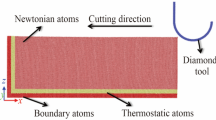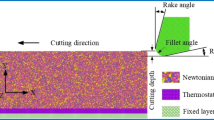Abstract
Beryllium is a typical hard cutting material because of its high hardness and brittleness. The laser allows rapid heating of the local material before removal, thus improving the machinability. In this paper, the machining properties of single crystal beryllium under different laser power were studied by using molecular dynamics (MD) method to simulate the micro-laser assisted cutting process. The cutting behavior of beryllium was characterized by cutting force, internal stress, crystal transformation in cutting area, internal dislocation of workpiece, chip and surface quality. During the cutting process, the laser promoted the crystal phase transition, revealed the reason of the significant increase in the number of 11-coordination beryllium atoms, and analyzed the change and distribution of the number of amorphous atoms in the crystal caused by the change of laser power. The effect of laser power on cutting force and equivalent stress in front of tool was investigated. The effects of laser parameters on atomic displacement and surface mass were studied by using the chip quantity and surface morphology obtained by simulation. The effect of laser on dislocation slip in crystal is studied by comparing the length and distribution region of various dislocation lines.
















Similar content being viewed by others

Data availability
Due to the large size of the data file, the data file is not disclosed, and the corresponding author can be obtained if requested by the author.
References
L. Xianping, H. Zhaopeng, L. Zaizhen, F. Yihang, Nano nickel base single crystal alloy cutting and surface defect evolution mechanism research. J. Mech. Sci. Technol. 41(07), 1062–1069 (2022). https://doi.org/10.13433/j.cnki.1003-8728.20200445
L.A.N. Hao Zhaopeng, F.Y. He, Analysis of tool wear in cutting single crystal nickel with sic tool based on molecular dynamics. Mech. Eng. 2019(09), 5–8 (2019)
Fu. Ma Shize, Z.L. Ting, L. Zhengyang, Molecular dynamics simulation of microgrooved diamond tool in nanocutting process of single crystal silicon. J. Wuhan Univ. Sci. Technol. 46(01), 47–52 (2023)
Yu. Zheng, Y. Xiaojing, L. Ning, Simulation study on plastic cutting mechanism and mechanical properties of polycrystalline germanium. Ordnance Mater. Sci. Eng. 43(01), 36–42 (2020). https://doi.org/10.14024/j.cnki.1004-244x.20191104.001
S. Yuanji, C. Cheng, W. Hantian, T. Bingyan, C. Xianbing, He. Yanhui, Z. Tao, Li. Junyan, G. Xunzhong, Study on the removal behavior of rigid abrasive particles from aluminum based materials based on molecular dynamics. Surface Technology 51(01), 229–239 (2022). https://doi.org/10.16490/j.cnki.issn.1001-3660.2022.01.024
Y. Yang Xiaojing, L.N. Zheng, Z. Lei, Molecular dynamics simulation of multiple cutting of single crystal germanium in nanoscale layering. J. Mater. Sci. Eng. 39(03), 437–444+451 (2021). https://doi.org/10.14136/j.cnki.issn1673-2812.2021.03.014
Su. Hao, T. Xingling, C. Cen, Molecular dynamics simulation of copper nanocutting. Tool Technol. 52(01), 89–92 (2018). https://doi.org/10.16567/j.cnki.1000-7008.2018.01.022
Wu. Ding Ye, G.Y. Xuefeng, W. Shuiwang, C. Mingjun, Y. Lijun, Aeronautical Manuf. Technol. 65(11), 30–47 (2022)
Wu. You, X. Xuefeng, J. Lei, Mechanism and technology of plastic field micromilling of beryllium materials. Tool Technol. 53(12), 74–76 (2019)
Q. Zhicong, X. Dawu, C. Xianglin, L. Dingmu, Effect of temperature on mechanical properties of beryllium. Rare Met. 39(01), 16–22 (2015). https://doi.org/10.13373/j.cnki.cjrm.2015.01.003
Dawu X, Zhicong Q, Xiangchao W, Lifeng H. Compression deformation behavior of beryllium metal Explosion and shock, 36(02), 285-288 (2016)
Wu. You, X. Xuefeng, P. Wenjie, Feasibility study on plastic field processing of beryllium materials. Manufacturing Technol. Mach. Tool 12, 105–108 (2019). https://doi.org/10.19287/j.cnki.1005-2402.2019.12.020
H. Dai, S. Li, G. Chen, Comparison of subsurface damages on mono-crystalline silicon between traditional nanoscale machining and laser-assisted nanoscale machining via molecular dynamics simulation. Beam Interact. Mater. Atoms 414, 61 (2023)
C. Li, Y.X. Hu, F.H. Zhang, Y.Q. Geng, B.B. Meng, Molecular dynamics simulation of laser assisted grinding of gan crystals. Int. J. Mech. Sci. 239, 107856 (2023). https://doi.org/10.1016/j.ijmecsci.2022.107856
Z. Liu, B. Lin, X. Liang, D. Anyao, Study on the effect of laser-assisted machining on tool wear based on molecular dynamics simulation. Diamond Related Mater. (2020). https://doi.org/10.1016/j.diamond.2020.108022
A. Agrawal, R. Mishra, L. Ward, K.M. Flores, W. Windl, An embedded atom method potential of beryllium. Modell. Simul. Mater. Sci. Eng. 21(8), 085001 (2013). https://doi.org/10.1088/0965-0393/21/8/085001.%3cGotoISI%3e://WOS:000327063600001
Acknowledgements
This research was supported by the National Natural Science Foundation of China (51975545) and the Nature Foundation of Shandong Province (ZR2022ME036).
Author information
Authors and Affiliations
Contributions
This paper was written by Wu Xuefeng, Tang Xinying and Qu Fengsheng. Tang Xinying independently completed the research design and data analysis, Tang Xinying took the lead in writing the paper, Wu Xuefeng proofread all drafts, Wu Xuefeng gave the first guidance for the paper, and Qu Fengsheng conducted an objective review of the paper. All authors have contributed to the further revision of this article. Wu Xuefeng gave important guidance in solving difficult or complex problems in the article. In addition, Wu Xuefeng and Qu Fengsheng went through the whole review process and confirmed the scientific nature of the article.Finally, all the authors have contributed to the writing and revision of the paper, and have some constructive suggestions and improvement suggestions to ensure that the paper can accurately express the complex research results.
Corresponding author
Ethics declarations
Conflict of interest
We declare that we have no conflict of interest.
Additional information
Publisher's Note
Springer Nature remains neutral with regard to jurisdictional claims in published maps and institutional affiliations.
Rights and permissions
Springer Nature or its licensor (e.g. a society or other partner) holds exclusive rights to this article under a publishing agreement with the author(s) or other rightsholder(s); author self-archiving of the accepted manuscript version of this article is solely governed by the terms of such publishing agreement and applicable law.
About this article
Cite this article
Wu, X., Tang, X. & Qu, F. Research on microlaser aided machinability of single crystal Beryllium cutting based on molecular dynamics. Appl. Phys. A 130, 248 (2024). https://doi.org/10.1007/s00339-024-07391-0
Received:
Accepted:
Published:
DOI: https://doi.org/10.1007/s00339-024-07391-0



